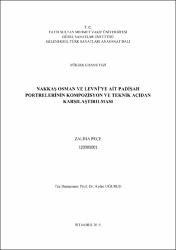| dc.contributor.advisor | Uğurlu, Aydın | |
| dc.contributor.author | Peçe, Zaliha | |
| dc.date.accessioned | 2015-12-10T07:33:45Z | |
| dc.date.available | 2015-12-10T07:33:45Z | |
| dc.date.issued | 2015 | |
| dc.date.submitted | 2015 | |
| dc.identifier.citation | PEÇE, Zaliha, Nakkaş Osman ve Levni’ye Ait Padişah Portrelerinin Kompozisyon ve Teknik Açıdan Karşılaştırılması, Fatih Sultan Mehmet Vakıf Üniversitesi Güzel Sanatlar Enstitüsü Geleneksel Türk Sanatları Anasanat Dalı, Yayımlanmamış Yüksek Lisans Tezi, İstanbul 2015 | en_US |
| dc.identifier.uri | https://hdl.handle.net/11352/2253 | |
| dc.description.abstract | Osmanlılarda padişah portreciliği 15. yüzyılda başlanmış olup bu dönemde padişah
portreleri tarih konulu yazmalardaki minyatürler içerisinde diğer figürlerle birlikte yer
almıştır. Sonraki dönemde padişah portreleri tek başlarına tam sayfayı kaplayacak
şekilde elyazmaları ve albümler içerisinde yer almaya başlamıştır. 16. yüzyılın sonunda
Nakkaş Osman’ın Kıyâfetü’l-İnsâniyye fî Şemâili’l-Osmâniyye için yapmış olduğu
padişah portreleri ile birlikte ise portreler bir hanedan kimliği oluşturmak için tarihi
metinlere paralel olarak yapılan padişah portre serilerine dönüşmüştür. Nakkaş
Osman’ın bu portreleri, Osmanlı klâsik portre geleneğini oluşturmuş olup bu kalıp
Levnî’ye gelene değin sonraki sanatçılar tarafından da devam ettirilmiştir. 18. yüzyılda,
Levnî’nin Kebir Musavver Silsilenâme için yapmış olduğu sade tezyini anlayıştaki
gerçekçi portreleri ile birlikte, Nakkaş Osman’ın kalıpları yerini Levnî’nin portre
kalıplarına bırakmıştır.
16. ve 18. yüzyıl gibi sosyokültürel açıdan birbirinden oldukça farklı iki ayrı döneme ait
olan ve her ikisi de portrecilikte döneminin mihenk taşını oluşturan TSMK, H. 1563
numaralı Kıyâfetü’l-İnsâniyye fî Şemâili’l-Osmâniyye ve TSMK, A. 3593 numaralı
Kebir Musavver Silsilenâme portrelerinde, bu iki dönem arasında görülen sosyokültürel
farklılığın izleri açıkça görülür. Bu izler, her iki portre serisinde gerek oluşturulmaya
çalışılan padişah imgeleri gerekse mekân kurgusu üzerinden net bir şekilde
okunabilmektedir.
Çalışma, dört ana başlık içerisinde incelenmiştir. İlk bölümü oluşturan giriş kısmında
çalışmanın kapsamı, amacı ve yöntemi, Osmanlılarda padişah portreciliği anlatılmıştır.
İkinci bölümde Nakkaş Osman döneminde kültür ve sanat ortamı, Nakkaş Osman’ın
hayatı, sanat anlayışı ve Kıyâfetü’l-İnsâniyye fî Şemâili’l-Osmaniyye adlı eser ile ilgili
genel bir bilgi verilmiştir. Üçüncü bölümde Levnî dönemindeki kültür ve sanat ortamı,
Levnî’nin hayatı, sanat anlayışı ve Kebir Musavver Silsilenâme adlı eser ele alınmıştır.
Dördüncü bölümde ise renkli çizimler eşliğinde iki eserin kompozisyon ve teknik
açıdan karşılaştırılması yapılmıştır. | en_US |
| dc.description.abstract | In the Ottomans, sultan portrait illustrations are first published in 15th century. In this
era, sultans portraits took a place in history topical manuscripts’s miniatures together
with the other figures. In the next era sultan portraits took a place singly in manuscripts
and albums in manner of full pages. At the end of the 16th century, with Nakkaş
Osman’s Kıyâfetü’l-İnsâniyye fî Şemâili’l-Osmâniyye portraits, sultan portraits
transformed into the sultans portraits series made correspondingly the text in order to
dynastic identify. Nakkaş Osman’s these portraits constituted the Ottoman classical
portrait tradition and his form is continued by artists until before Levnî. With the
Levnî’s plain realistic portraits illustrated for Kebir Musavver Silsilenâme, Levnî’s
portrait forms are replaced by Nakkaş Osman’s illustration forms in 18th century.
The huge socio-cultural differences between 16th and 18th are clearly visible in both
TSMK, H. no:1563 Kıyâfetü’l-İnsâniyye fî Şemâili’l-Osmâniyye and TSMK, A.
No:3593 Kebir Musavver Silsilenâme portraits, which are respected as the documentary
milestones of the 16th and18th century. These signs are cleary observed either through
the location scenario or through the sultan signs in both portrait series.
The work consists of four main headers. In the entry forming the first chapter, the
content, the purpose and the method of this research, the sultan portrait illustration in
the Ottomans were explained. In the second chapter, cultural and the art life in Nakkaş
Osman’s period, life of Nakkaş Osman, his artistic view and Kıyâfetü’l- İnsâniyye fî
Şemâili’l-Osmaniyye were mentioned. In the third chapter, cultural and the art life in
Levnî’s period, life of Levnî, his artistic view, Kebir Musavver Silsilenâme were
mentioned. And in the fourth chapter, two work were compared in terms of
compositions and technical by means of coloured drawings. | en_US |
| dc.language.iso | tur | en_US |
| dc.publisher | Fatih Sultan Mehmet Vakıf Üniversitesi, Güzel Sanatlar Enstitüsü | en_US |
| dc.rights | info:eu-repo/semantics/openAccess | en_US |
| dc.subject | Nakkaş Osman | en_US |
| dc.subject | Levnî | en_US |
| dc.subject | Minyatür | en_US |
| dc.subject | Padişah Portreciliği | en_US |
| dc.subject | III. Murad Dönemi Portrecilik | en_US |
| dc.subject | III. Ahmed Dönemi Portrecilik | en_US |
| dc.subject | Miniature | en_US |
| dc.subject | Sultan Portraits | en_US |
| dc.subject | Portraits in the III. Murad’s Era | en_US |
| dc.subject | Portraits in the III. Ahmed’s Era | en_US |
| dc.title | Nakkaş Osman ve Levni’ye Ait Padişah Portrelerinin Kompozisyon ve Teknik Açıdan Karşılaştırılması | en_US |
| dc.type | masterThesis | en_US |
| dc.contributor.department | FSM Vakıf Üniversitesi, Güzel Sanatlar Enstitüsü | en_US |
| dc.relation.publicationcategory | Tez | en_US |
| dc.contributor.institutionauthor | Peçe, Zaliha | |



















